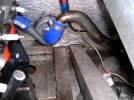Trying to sort out where to mount a remote water pump. I've searched the forums and there is some very helpful information but I am getting mixed inputs on whether the pump should be up front near the radiator or in the back by the engine.
Is this a preference thing or is there valid reasoning why one location is better than the other?
Is this a preference thing or is there valid reasoning why one location is better than the other?


